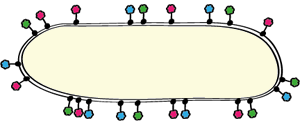Team:Edinburgh
From 2011.igem.org
(→Questions) |
|||
| Line 55: | Line 55: | ||
* Is it possible to improve the efficiency of cellulases by displaying them on a phage? | * Is it possible to improve the efficiency of cellulases by displaying them on a phage? | ||
* How would a biorefinery involving either system actually be constructed? | * How would a biorefinery involving either system actually be constructed? | ||
| + | * Would such a biorefinery be economically viable? | ||
* What are the social implications of creating such a biorefinery? | * What are the social implications of creating such a biorefinery? | ||
* What are people's thoughts and feelings regarding this project? | * What are people's thoughts and feelings regarding this project? | ||
Revision as of 15:13, 19 August 2011
A biorefinery is a special type of refinery in which biomass, such as plant cellulose, is converted by microorganisms into useful products. Edinburgh's 2011 iGEM project is a feasibility study into the creation of biorefineries using E. coli, the workhorse of synthetic biology, and whether biorefineries can be improved by arranging for the different enzymes involved to be in close proximity to each other, so as to create synergy between them.
Synergy
In many applications, several enzymes are needed to produce the desired product. And it is often the case that these enzymes work synergistically; meaning their efficiency is increased if they are in close proximity.
Last year, Slovenia found a way to achieve synergy in the periplasm. This year, Edinburgh is investigating whether such synergy can be achieved outside the cell.
We will attempt to create microscopic reaction scaffolds holding various enzymes that carry out reactions in the extracellular environment. Our hope is that, by combining the activity of multiple enzymes in a small space, high efficiency will be achieved. Two different systems are being investigated.
Cell surface display
The simplest system uses E. coli bacteria as the scaffold. Each bacterium generates several enzymes and displays them on its outer membrane. If sufficiently high numbers are present on each cell, the synergystic effect should be achieved.
To achieve a high expression level, we will attempt to use ice nucleation protein as a carrier for enzymes; [http://www.sciencedirect.com/science/article/pii/S016777991000199X Van Bloois et al (2011)] speak highly of INP, and claim that it can be displayed at a copy number of around 100,000 copies per cell without affecting viability.
Phage display
A more radical proposal involves use M13 phage as the scaffold, and attaching enzymes by phage-display techniques to the pVIII coat protein.
If multiple copies of the enzymes could be attached to a single phage, then synergy should be achieved.
Biorefineries in society
We believe that it is insufficient to ask whether the low-level biological challenges can be overcome. There are also engineering and economic problems to consider, and so we have worked on an actual design for a large-scale physical biorefinery.
More than this, political and social implications of biorefineries demand our attention. We must ask not only whether we can do something, but also whether we should. Answering this question is one of the most important parts of our feasibility study.
Questions
Our feasibility study therefore seeks to answer the following questions:
- Is it possible to improve the efficiency of cellulases by displaying them on a cell outer membrane?
- Is it possible to improve the efficiency of cellulases by displaying them on a phage?
- How would a biorefinery involving either system actually be constructed?
- Would such a biorefinery be economically viable?
- What are the social implications of creating such a biorefinery?
- What are people's thoughts and feelings regarding this project?
- Should we actually build such a biorefinery?
References
- Van Bloois E, Winter RT, Kolmar H, Fraaije MW (2011) [http://www.sciencedirect.com/science/article/pii/S016777991000199X Decorating microbes: surface display of proteins on Escherichia coli]. Trends in Biotechnology 29(2): 79-86 (doi: 10.1016/j.tibtech.2010.11.003).
 "
"


